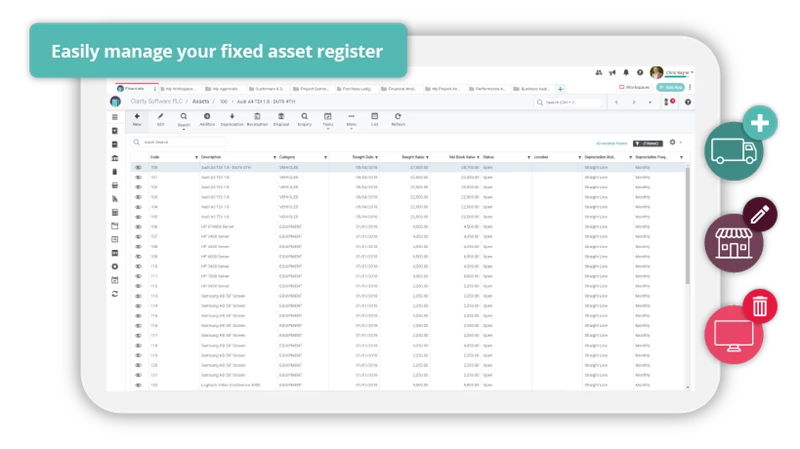
What is a fixed asset register?
Have you ever wondered what exactly is a fixed asset register? Why does a business need a fixed asset register? And are you approaching the compilation of your fixed asset register correctly?
Read on to discover everything you need to know, starting with the formal definition of a fixed asset register; including who in your business should be responsible for putting the fixed asset register together (and maintaining it); as well as some examples of what to include in your fixed asset register. We’ll also include some useful tips on how to automate the process and save time.
 6 minutes
6 minutes
Written by Matt Jones, Finance software specialist
Information on this page
- Fixed asset definition
- What is a fixed asset in accounting?
- Examples of fixed assets in accounting
- The purpose of a fixed asset register
- What to include in a fixed asset register
- What does a fixed asset register look like?
- Who is responsible for a fixed asset register?
- How to automate your fixed asset register process
Fixed asset register definition
Let’s start with the basics: What is a fixed asset register in accounting? In simple terms, a fixed asset register is a formal record of all the assets (or physical entities) owned by the company as well as their value. Many businesses also include other useful information such as the location of the asset, individual details such as ID numbers, who in the company is responsible for the asset, and other finance details such as the internal cost centre it is logged against and any depreciation numbers.
What is a fixed asset in accounting?
The main characteristics of a fixed asset from an accounting perspective are as follows:
- Its purpose is to help the company operate and generate revenue
- It will have a usable life of at least a year
- It’s value is depreciating due to wear and tear (this doesn’t apply to land and estates)
- It can’t easily be converted into cash (like saleable products for example which are not fixed assets)
Examples of fixed assets in accounting
Fixed assets in accounting are often summarised as ‘plant, property and equipment’. Examples of what specifically can be included are shown below:
- IT equipment such as computers, hardware, software and servers, screens, printers, sound systems and other devices.
- Furniture and fittings including desks and chairs, physical storage, tools etc.
- Land and estates are fixed assets if they are owned by the business. This includes not only the buildings but also the car park for example which has a value.
- Vehicles and machinery includes company cars used for generating income (not personal use) vans, trucks etc. as well as company owned equipment which can mean anything from industrial cleaning machines to forklift trucks for example.
What is the purpose of a fixed asset register?
The purpose of a fixed asset register is to keep an accurate record – not only of the physical details and value of the asset, but also to ensure that information is kept up-to-date and readily available if a particular asset needs to be identified or verified. It provides valuable insight that helps business leaders to make more informed decisions.
One of the key benefits of maintaining a fixed asset register is that in helps the Finance team to show an accurate picture of the true value of the business. This is useful in various circumstances – such as when conducting financial analysis, when reporting on the overall health of the business, when demonstrating value to potential investors, or when seeking to borrow money.
Each time a fixed asset is acquired or disposed of, it is recorded in the company accounting software and cash flow statement as either a cash outflow (purchases) or a cash inflow (fixed asset sale).
Sectors which have to invest heavily in their fixed assets (such as buying machinery for example) are particularly capital intensive. Keeping an accurate fixed asset register is vital here as it shows that reporting an overall negative cash flow is the result of purchasing more assets – and this in turn is a positive factor as the business is investing because it is successfully growing.
What to include in a fixed asset register
It is useful to include as much relevant information as possible in your fixed asset register. Exactly what to include will vary from business to business, depending on the specifics of your fixed asset portfolio. Consider the following data for inclusion:
- Asset identification data – such as the asset name as well as any unique identifiers such as serial numbers or barcodes.
- Asset description – this can include a variety of data such as what the asset is and does, the date of purchase, who uses it.
- Location – this should be specific to the exact location, not just an address or building but enough detail for someone to quickly locate the asset within the building.
- Usage data – this is helpful when determining the changing lifetime value of an asset. Equipment which is used infrequently will have a different lifespan than high use or damaged equipment for example.
- Compliance and maintenance information – is helpful evidence to determine the true value of a fixed asset; it’s also useful for auditing or inspection purposes.
- Financial information – this includes a variety of data such as purchase cost, depreciation, salvage value (if it was broken down and sold as parts), and cost centre.
- Insurance and warranty data – storing this information by individual asset means it is quickly to hand if an event occurs; it’s also helpful to have alerts set for when coverage expires so that new arrangements can be made in good time.
What does a fixed asset register look like?
Fixed asset registers come in all shapes and sizes, depending on the specific needs and preferences of the individual business and of the Finance team responsible for it. It was common in the past for it to be maintained on a spreadsheet for example, however the difficulty with this is that it can be hard to keep up-to-date if only one or a limited number of people have access to it, or if there are multiple versions in circulation.
It's now more common – and much more effective – to maintain the fixed asset register within the Finance software system. Below is an example of this which is featured within Access Financials.

Who is responsible for a fixed asset register?
The task of setting up and maintaining a fixed asset register usually sits with the Finance Manager as a larger proportion of the data held is financial and is used for finance purposes. In some organisations, it can be kept updated by more than one person – for example the Facilities Manager may deal with the purchase and maintenance of plant and machinery so will be a frequent user of the asset register.
How to automate your fixed asset register process
One of the biggest challenges for the individual(s) responsible for maintaining the company fixed asset register is keeping the data up-to-date. And the larger your fixed asset register becomes, the more complex it gets. That’s exactly the point when using software to manage your fixed asset register can be especially useful and significantly more effective.
One example worth considering is the fixed asset software module included within Access Financials our cloud based finance solution.
Got a question about fixed asset software?
Why not contact us now to discuss how our fixed asset register software could make your life easier? You might find that it saves your business a lot of time and resource and can make the process of managing your fixed assets more streamlined and effective.

